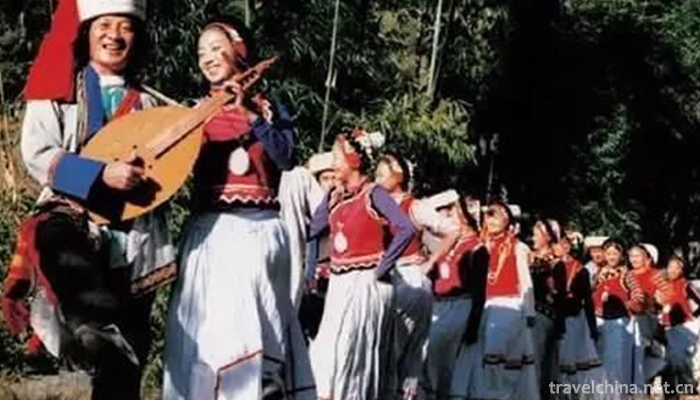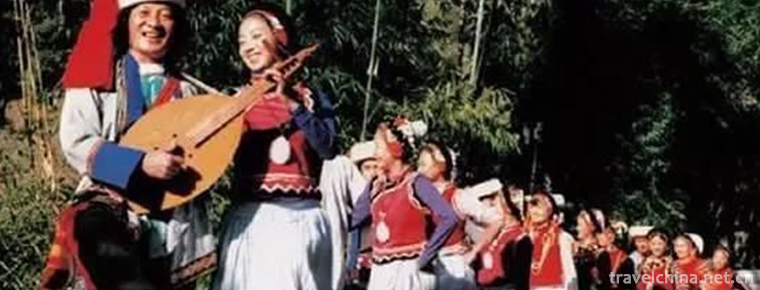Nu Dabian Dance
Nu Dabian Dance
"Dabian Dance" is one of the representative dances of the Nu nationality, which is spread in the Nujiang Lisu Autonomous Prefecture Fugong County Nu villages. Dabian dance is characterized by dancers holding "Dabian" while playing. "Dabiea" is a traditional instrument of Nu nationality, similar to Pipa and four strings. The upper body posture of Dabian dance is very rich, including left and right high, flat, low, back, rebound and so on. There are two main styles of dance steps: one is the knee flexion and extension belt to send the hip rhythm of foot, point, planer, negotiation; the other is the flexion and extension belt to turn the rhythm of foot, point, planer, negotiation, hook, negotiation, flexion and extension is relatively small. The other is the flexion and extension belt to turn the rhythm of foot, point, planer, negotiation, hook.
On November 11, 2014, Nu Dabian Dance was approved by the State Council to be included in the fourth batch of national intangible cultural heritage list.
information
The Dabian Dance of Nu Nationality is Provincial III-13. The rhythm of Dabian Dance is mostly at medium speed. The knee bends and stretches once per beat of music, which requires uniformity and tenacity. This has a certain relationship with the national character stability. The basic rhythm of flexion, extension and tremor in Dabian dance has detailed requirements in the folk. When artists teach, they first emphasize that the knee joint should not be stiff, but should have a sense of tremor. As for how to master rhythm, it is emphasized that the "heart" should be used when flexion and extension flutter, that is, internal feeling, not only external flutter. It is not difficult to see that their requirements for the basic rhythm of flexion, extension and tremor in Dabian dance are extremely strict.
In a word, the three main points of forming the unique rhythm of Dabian dance are the right and left crotch delivery, the right and left turn, and the flexion and extension tremor. They are also the main factors of forming the unique style of Dabian dance.
Characteristic
The content and steps of Dabian dance are basically the same in all villages. In some villages, there are two kinds of end action combination after some dances. We call them "end combination one" and "end combination two". When a dance is finished and a combination of the ends is added, the speed of music and dance will be accelerated, so that the dance will end in a more pleasant atmosphere.


-
1.Seven Stars Scenic Spot
Seven Stars Scenic Spot/Qixing Scenic Spot is located on the East Bank of Lijiang River in Guilin City, along Xiaodong River, a tributary of Lijiang River, 1.5 kilometers away from the city center.
Time 2018-12-17 -
2.Luzhi Ancient town
Yongzhi Ancient Town belongs to Wuzhong District of Suzhou City. It is located in the east of Suzhou City. It is 18 kilometers west of Suzhou City and 58 kilometers east of Shanghai.
Time 2019-02-06 -
3.Songxian Tianchishan National Forest Park
The Tianchishan National Forest Park in Songxian County, Luoyang City, is located in Xionger Mountains, northwest of Songxian County, Luoyang City, with a total area of 1716 hectares and a forest cove
Time 2019-02-13 -
4.Shanghai Yuehu Sculpture Park
Yuehu Sculpture Park is located in Sheshan National Tourism Resort, Songjiang District, Shanghai. It is built around the lake. It is a sculpture art park which combines natural scenery with modern lan
Time 2019-03-09 -
5.Kazakh Aytes
Kazakh Aytes is a typical representative of Kazakh folk art, a competitive form of performance, is the most abundant content of Kazakh folk oral literature, the most influential literary type among th
Time 2019-05-02 -
6.Chinese character calligraphy
Chinese character calligraphy has been recognized by the world for its brilliant civilization of 5000 years and its incomparable rich written records. In this vast and profound history,
Time 2019-05-02 -
7.Shui Shui Custom
"Shuishu" is a prototype written by the ancestors of the Shui nationality of the minority nationalities in Southwest China. Shui Shu custom is the formation, development and inheritance of S
Time 2019-06-15 -
8.the Wu Ballads
Wuge is the oral literary creation of the majority of the people in Wu dialect area, which originated in southeastern Jiangsu Province, and Suzhou is the central area for the generation and developmen
Time 2019-06-29 -
9.Hunan Opera
Hunan Opera, is one of the traditional operas in Hunan Province. It is popular in Changsha and Xiangtan, mainly in the twelve genera of Changsha Mansion, namely Changsha, Shanhua, Xiangyin, Liling, Xi
Time 2019-07-03 -
10.Cultural corridor of Confucianism Buddhism and Taoism
Emei Mountain Confucian, Buddhist and Taoist cultural corridor inherits and develops Chinese traditional culture through different aspects, and excavates its own value and charm from Emei Mountain's historical culture, and highlights its connotation of "China's first mountain".
Time 2020-10-15 -
11.Neijiang ten sages
Ten sages are outstanding representatives of historical figures in Neijiang, which are described as "one division, two phases, three number one scholars and four great masters";
Time 2020-12-16 -
12.Dazhou culture
Baqu culture refers to the fact that Dazhou city is located in Bashan canal and belongs to Badi in ancient times. The chapter of Baqu customs is listed in the ancient book Taiping Huanyu Ji thousands of years ago; the second refers to the unique cultur
Time 2020-12-20